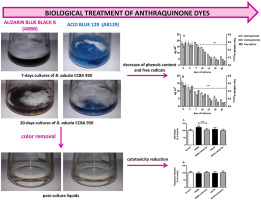当前位置:
X-MOL 学术
›
Ecotox. Environ. Saf.
›
论文详情
Our official English website, www.x-mol.net, welcomes your
feedback! (Note: you will need to create a separate account there.)
Biotransformation and toxicity effect of monoanthraquinone dyes during Bjerkandera adusta CCBAS 930 cultures.
Ecotoxicology and Environmental Safety ( IF 6.2 ) Pub Date : 2020-01-20 , DOI: 10.1016/j.ecoenv.2020.110203 K Rybczyńska-Tkaczyk 1 , T Korniłłowicz-Kowalska 1 , K A Szychowski 2 , J Gmiński 2
Ecotoxicology and Environmental Safety ( IF 6.2 ) Pub Date : 2020-01-20 , DOI: 10.1016/j.ecoenv.2020.110203 K Rybczyńska-Tkaczyk 1 , T Korniłłowicz-Kowalska 1 , K A Szychowski 2 , J Gmiński 2
Affiliation

|
The aim of this study was to evaluate of possibility of biotransformation and toxicity effect of monoanthraquinone dyes in cultures of Bjerkandera adusta CCBAS 930. Phenolic compounds, free radicals, phytotoxicity (Lepidium sativum L.), ecotoxicity (Vibrio fischeri) and cytotoxicity effect were evaluated to determine the toxicity of anthraquinone dyes before and after the treatment with B. adusta CCBAS 930. More than 80% of ABBB and AB129 was removed by biodegradation (decolorization) and biosorption, but biodegradation using oxidoreductases was the main dye removing mechanism. Secondary products toxic to plants and bacteria were formed in B. adusta strain CCBAS 930 cultures, despite efficient decolorization. ABBB and AB129 metabolites increased reactive oxygen species (ROS) production in human fibroblasts, but did not increase LDH release, did not affect the resazurine reduction assay and did not change caspase-9 or caspase-3 activity.
中文翻译:

Bjerkandera adusta CCBAS 930培养期间单蒽醌染料的生物转化和毒性作用。
这项研究的目的是评估单蒽醌染料在Bjerkandera adusta CCBAS 930培养物中的生物转化和毒性作用的可能性。评估了酚类化合物,自由基,植物毒性(Lepidium sativum L.),生态毒性(弧菌)和细胞毒性作用。以确定蒽醌染料在B. adusta CCBAS 930处理之前和之后的毒性。通过生物降解(脱色)和生物吸附去除了超过80%的ABBB和AB129,但是使用氧化还原酶进行生物降解是主要的染料去除机理。尽管有效脱色,但在印度芽孢杆菌CCBAS 930培养物中形成了对植物和细菌有毒的次级产物。ABBB和AB129代谢物增加了人类成纤维细胞中的活性氧(ROS)产生,但并未增加LDH的释放,
更新日期:2020-01-21
中文翻译:

Bjerkandera adusta CCBAS 930培养期间单蒽醌染料的生物转化和毒性作用。
这项研究的目的是评估单蒽醌染料在Bjerkandera adusta CCBAS 930培养物中的生物转化和毒性作用的可能性。评估了酚类化合物,自由基,植物毒性(Lepidium sativum L.),生态毒性(弧菌)和细胞毒性作用。以确定蒽醌染料在B. adusta CCBAS 930处理之前和之后的毒性。通过生物降解(脱色)和生物吸附去除了超过80%的ABBB和AB129,但是使用氧化还原酶进行生物降解是主要的染料去除机理。尽管有效脱色,但在印度芽孢杆菌CCBAS 930培养物中形成了对植物和细菌有毒的次级产物。ABBB和AB129代谢物增加了人类成纤维细胞中的活性氧(ROS)产生,但并未增加LDH的释放,











































 京公网安备 11010802027423号
京公网安备 11010802027423号